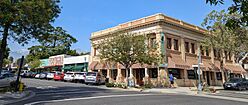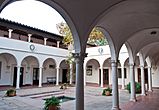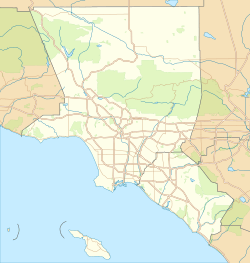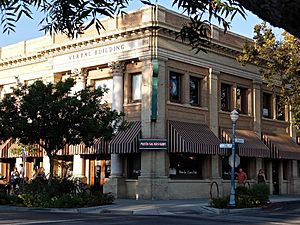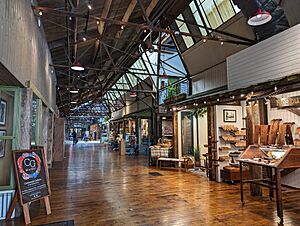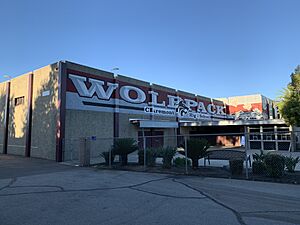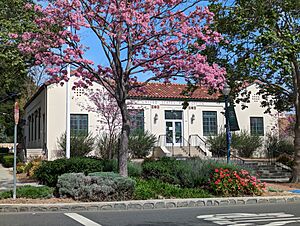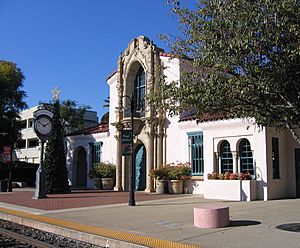Claremont, California facts for kids
Quick facts for kids
Claremont, California, United States
|
|||
|---|---|---|---|
|
|
|||
|
|||
| Nickname(s):
City of Trees and PhDs
|
|||
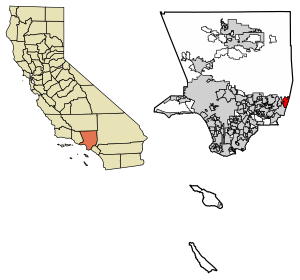
Location of Claremont in Los Angeles County, California
|
|||
| Country | United States | ||
| State | California | ||
| County | Los Angeles | ||
| Incorporated | October 3, 1907 | ||
| Government | |||
| • Type | Council–manager | ||
| Area | |||
| • Total | 13.47 sq mi (34.89 km2) | ||
| • Land | 13.34 sq mi (34.54 km2) | ||
| • Water | 0.14 sq mi (0.35 km2) 1.03% | ||
| Elevation | 1,168 ft (356 m) | ||
| Population
(2020)
|
|||
| • Total | 37,266 | ||
| • Density | 2,794.60/sq mi (1,079.01/km2) | ||
| Time zone | UTC−8 (PST) | ||
| • Summer (DST) | UTC−7 (PDT) | ||
| ZIP Code |
91711
|
||
| Area code | 909 | ||
| FIPS code | 06-13756 | ||
| GNIS feature IDs | 1652685, 2409465 | ||
| Commuter rail | Claremont |
||
Claremont (/ˈklɛərmɒnt/) is a city in Los Angeles County, California, United States. It is about 30 miles (48 km) east of Los Angeles. The city is located in the Pomona Valley, near the San Gabriel Mountains. In 2020, about 37,266 people lived there.
Claremont is famous for its seven Claremont Colleges and other schools. It's also known for its many tree-lined streets and old buildings. People sometimes call it "The City of Trees and Ph.Ds." In 2016, Sunset Magazine named it the best suburb in the West. They said it was a "small city that blends worldly sophistication with small-town appeal."
Most of Claremont is residential, meaning people live there. There are also many shops and restaurants in an area called "The Village." This area is popular and close to the Claremont Colleges. In 2007, The Village grew to include a movie theater, a hotel, and more shops. Claremont also has several large communities for retired people.
Claremont has won the National Arbor Day Association's Tree City USA award for 22 years in a row. When the city became official in 1907, people started planting trees. This became a city tradition. Claremont is one of the few places in North America with American Elm trees that are safe from Dutch elm disease. These tall trees line Indian Hill Boulevard near the city's Memorial Park.
Contents
History of Claremont
Before Claremont was a city, the Serrano, Cahuilla, and Tongva tribes lived here for thousands of years. The Tongva people had villages as early as 7000 B.C. They used the fresh water from what the Spanish later called the San Antonio Creek. One Tongva village, called Torojoatngna, was at a spot known as "Indian Hill." This village was active until the 1800s. It was sadly abandoned after a smallpox epidemic in 1883.
Claremont was first planned by developers during a land boom. This happened when transcontinental railroads came to Southern California. The city was probably named after Claremont, New Hampshire. The early history of Claremont is closely linked to Pomona College, which moved there in 1889. In 1902, people voted to name east-west streets with numbers and north-south streets after colleges. The city officially became a city in 1907.
The citrus groves and open spaces that once covered the northern part of the city are now mostly homes. Construction of the Stone Canyon Preserve began in 2003. This was part of a deal that created the 1,740-acre (704 ha) Wilderness Park. This area also includes the historic Padua Hills Theatre and the Claraboya neighborhood.
Claremont's Geography
Claremont covers about 13.35 square miles (34.6 km2). Most of this is land, with a small amount of water. Claremont is at the eastern edge of Los Angeles County. It borders the cities of Upland and Montclair in San Bernardino County. It also borders Pomona and La Verne in Los Angeles County.
Claremont's Climate
Claremont has a Mediterranean climate. This means it has warm, dry summers and mild, wet winters. In summer, temperatures can get very high, sometimes over 100°F (38°C). In autumn, strong "Santa Ana Winds" can blow. These winds can increase the risk of fires in the foothill areas.
Most of the city's rain falls in winter. Snow is rare in Claremont itself. However, you can often see snow on the nearby San Gabriel Mountains in winter. In late spring, Claremont can have many cloudy days. This is due to cool air coming from the ocean. People often call this "May Gray" or "June Gloom."
| Climate data for Claremont, California | |||||||||||||
|---|---|---|---|---|---|---|---|---|---|---|---|---|---|
| Month | Jan | Feb | Mar | Apr | May | Jun | Jul | Aug | Sep | Oct | Nov | Dec | Year |
| Mean daily maximum °F (°C) | 68 (20) |
69 (21) |
71 (22) |
76 (24) |
79 (26) |
84 (29) |
90 (32) |
92 (33) |
89 (32) |
80 (27) |
74 (23) |
68 (20) |
78.0 (25.6) |
| Mean daily minimum °F (°C) | 43 (6) |
45 (7) |
47 (8) |
49 (9) |
54 (12) |
58 (14) |
62 (17) |
62 (17) |
60 (16) |
55 (13) |
47 (8) |
42 (6) |
52 (11) |
| Average precipitation inches (mm) | 3.11 (79) |
4.76 (121) |
2.63 (67) |
1.20 (30) |
0.23 (5.8) |
0.09 (2.3) |
0 (0) |
0.03 (0.76) |
0.15 (3.8) |
1.05 (27) |
1.62 (41) |
2.45 (62) |
17.32 (439.66) |
Claremont's Population
| Historical population | |||
|---|---|---|---|
| Census | Pop. | %± | |
| 1930 | 2,719 | — | |
| 1940 | 3,057 | 12.4% | |
| 1950 | 6,327 | 107.0% | |
| 1960 | 12,633 | 99.7% | |
| 1970 | 24,776 | 96.1% | |
| 1980 | 31,028 | 25.2% | |
| 1990 | 32,503 | 4.8% | |
| 2000 | 33,998 | 4.6% | |
| 2010 | 34,926 | 2.7% | |
| 2020 | 37,266 | 6.7% | |
| U.S. Decennial Census | |||
In 2020, Claremont had a population of 37,266 people. Most residents lived in homes, while some lived in group housing like college dorms. The city has a mix of different ethnic backgrounds. Many families live in Claremont, and about 30% of households have children under 18. The average age in Claremont is about 38.6 years old.
Economy and Jobs
Claremont has a strong economy with many job opportunities. The largest employers are often related to education and healthcare.
Top Employers in Claremont
Here are some of the biggest employers in Claremont:
| # | Employer | # of employees |
|---|---|---|
| 1 | Claremont Colleges | 3,000 |
| 2 | Claremont Unified School District | 750 |
| 3 | HiRel Connectors | 300 |
| 4 | City of Claremont | 259 |
| 5 | Claremont Auto Center | 240 |
| 6 | Claremont Manor | 230 |
| 7 | Technip Energies | 205 |
| 8 | Pilgrim Place | 180 |
| 9 | Indian Hill Nursing | 124 |
| 10 | The Webb Schools | 119 |
Arts and Culture
Claremont is known for its lively arts and culture scene. There are many ways to enjoy music, art, and theater here.
Every spring, Claremont hosts a folk music festival. It is put on by the Folk Music Center Store and Museum. The festival has been happening for many years.
Local museums include the Raymond M. Alf Museum of Paleontology at The Webb Schools. This is the only high school in the U.S. with a nationally recognized museum on its campus. There is also the Benton Museum of Art at Pomona College.
Each July, Ophelia's Jump Productions puts on their Midsummer Shakespeare Festival. These plays are performed outdoors at Pomona College.
The Claremont Village also has a Pie Day Festival every March 14. In the past, people could collect pie recipes while exploring the downtown shops.
In 2019, a church in Claremont created a special nativity scene. It showed Joseph, Mary, and baby Jesus in separate chain-link pens. This was done to show the struggles of immigrants and asylum seekers. The church has made unique nativity scenes in other years too.
Fun Places to Visit
- The Claremont Colleges
- The California Botanic Garden has a huge collection of California native plants. You can take self-guided walking tours there.
- Padua Hills Theatre
- Folk Music Center Museum
- Claremont Museum of Art
- Ophelia's Jump Theater
- Benton Museum of Art, Pomona College
Education in Claremont
Claremont is well-known for its many schools, from elementary to college level.
Public Schools
The public school district in Claremont is called the Claremont Unified School District (CUSD). It has seven elementary schools, one middle school (El Roble), one adult school, and two high schools. The high schools are Claremont High School (CHS) and San Antonio High School.
Private Schools (Before College)
Another high school in Claremont is The Webb Schools. This is a group of two private college preparatory schools for grades 9–12. They were started by Thompson Webb in 1922. The two schools, Webb School of California (for boys) and Vivian Webb School (for girls), share the same campus. The Vivian Webb Chapel on campus was built for Thompson Webb's wife, Vivian. The Webb Schools is also home to the Raymond M. Alf Museum of Paleontology. This is the only accredited museum in America located on a high school campus.
Colleges and Universities

Claremont is home to about 6,500 college students from all over the world. The Claremont Colleges are a group of seven higher education schools. They include five undergraduate colleges: Pomona College (founded 1887), Scripps College (1926), Claremont McKenna College (1946), Harvey Mudd College (1955), and Pitzer College (1963). There are also two graduate schools: Claremont Graduate University (1925) and the Keck Graduate Institute of Applied Life Sciences (1997). These schools are often ranked among the best in the country.
The Robert J. Bernard Field Station is owned by the colleges. It helps protect natural plant areas. Claremont Lincoln University is also in Claremont, but it is a separate school. The Claremont School of Theology used to be in Claremont but moved to Los Angeles in 2023.
Media and News
The Claremont Courier is the main local newspaper for Claremont. In 2018, it was named the best community newspaper in California. Students at Claremont High School also create their own newspaper, The Wolfpacket.
The Claremont Colleges have their own media too. This includes The Student Life, which is the oldest college newspaper in Southern California. There is also a radio station called KSPC.
Transportation
You can travel to Claremont by train using Metrolink. The Claremont Metrolink Station is on the San Bernardino Line. Trains go to Los Angeles and San Bernardino. The train station building is known as the Claremont Depot.
Claremont will also connect to the Metro A Line in the future. This extension is planned to be finished by 2030. It will also provide train service to Los Angeles.
FlixBus also has a stop next to the Metrolink Station. For local travel, the Foothill Transit bus service covers Claremont and nearby cities.
Notable People from Claremont
- Jessica Alba – actress
- Matthew Arias – musician and film editor
- Richard Armour – writer, English professor
- Tony Beltran – soccer player
- Arthur T. Benjamin – mathematician
- Karl Benjamin – artist
- Jacob Bertrand – actor
- Amanda Blake – actress
- Brittany Brown – Olympic sprinter
- Buckethead – musician
- Robert Buckley – actor
- Kori Carter – hurdler
- John B. Cobb – theologian, philosopher, and environmentalist
- Ray Collins – musician
- John Darnielle – musician and novelist
- Glenn Davis – football player
- David Dreier – former member of the U.S. House of Representatives
- Peter F. Drucker – management consultant, educator and author
- Bob Earl – racing driver
- B. H. Fairchild – poet and college professor
- Justin Germano – baseball pitcher
- Elliot Graham – film editor and producer
- Ben Harper – musician and humanitarian
- Alex Hinshaw – baseball pitcher
- Raja Kumari – rapper
- Maud Hart Lovelace – author
- Sam Quinones – journalist and author
- Dileep Rao – actor
- Millard Sheets – artist and designer
- Paul Soldner – artist
- Noah Song – professional baseball pitcher
- Ruth Suckow – author
- David Foster Wallace – author and professor
- Carleton H. Wright – United States Navy admiral
- Frank Zappa – musician
See also
 In Spanish: Claremont (California) para niños
In Spanish: Claremont (California) para niños


